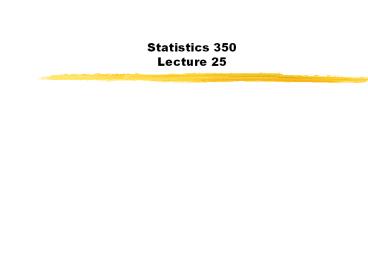Statistics 350 Lecture 25 PowerPoint PPT Presentation
Title: Statistics 350 Lecture 25
1
Statistics 350 Lecture 25
2
Today
- Last Day Start Chapter 9 (9.1-9.3)please read
9.1 and 9.2 thoroughly - Today More Chapter 9stepwise regression
3
Stepwise Variable Selection
- Three categories of stepwise variable selection
4
Forward Selection
- For all methods considered today, have P-1
possible predictors and 2P-1 possible models - Start with no variables in model
- Select a significance level at which variables
can be included in the model - Find the critical value of F for this level
FENTER
5
Forward Selection
- Consider every possible 1-variable model,
6
Forward Selection
- Each time a variable is entered into the model
(i.e. the maximum F is big enough), then use the
newly-augmented model as the base model - Check extra SS for each remaining variable
- For example, if Xa is entered, then at the next
step, check all SSR(XkXa) for all variables
(other than Xa, which is already in the model) - Keep adding variables and revising the base model
until at some step F lt FENTER. Then no more
variables can be added.
7
Forward Selection
- The final model is the last base model.
- Procedure gives a single model, declared best by
the procedure - Also, once a variable is added, it can never be
removed, even if subsequent additions render it
unimportant (e.g. through multi-collinearity)
8
Backward Elimination
- Start with all varaibles
9
Backward Elimination
- Consider all possible 1-varaible reduction in the
model size
10
Backward Elimination
- Each time a variable is dropped, use the revised
model as the base model and check all the extra
SS for variables remaining in the model - Keep eliminating variables and revising the model
until all variables remaining in the model have
Fk gt FSTAY
11
Backward Elimination
- Gives a best model according to this criterion
- It may differ from the one given in Forward
Selection - Once a variable is removed, it remains out of the
model, even if subsequent eliminations render it
useful
12
Stepwise Selection
- Alternates between Forward and Backward steps to
address the problems noted above - Start with no variables in the model
13
Stepwise Selection
- After each Backward phase, use the revised model
as the base model from which to begin another
round of Forward/Backward - Continue until no further variables can be added
or removed
14
Stepwise Selection
- Note that in each forward phase, only one
variable can be added before the new model is
trimmed with (possibly multiple steps of)
backward elimination - The final model may or may not match either of
the models obtained using Forward Selection or
Backward Elimination alone
15
Comments
- In all cases, methods based on insertion or
deletion criteria - In forward steps
- In backward steps
16
Comments
- Significance level is a personal decision
- Common practice in regression to use slightly
higher levels of a in allowing variables to enter
into or remain in the model than in other testing
situations
17
Comments
- Note that in Stepwise Selection, you must arrange
for aENTER lt a STAY - or, equivalently, FENTER gtFSTAY
- Otherwise, a variable's p-value could be small
enough to include but large enough to eliminate
in each step, leading to an infinite loop - One suggestion is to use a STAY 2 a ENTER

